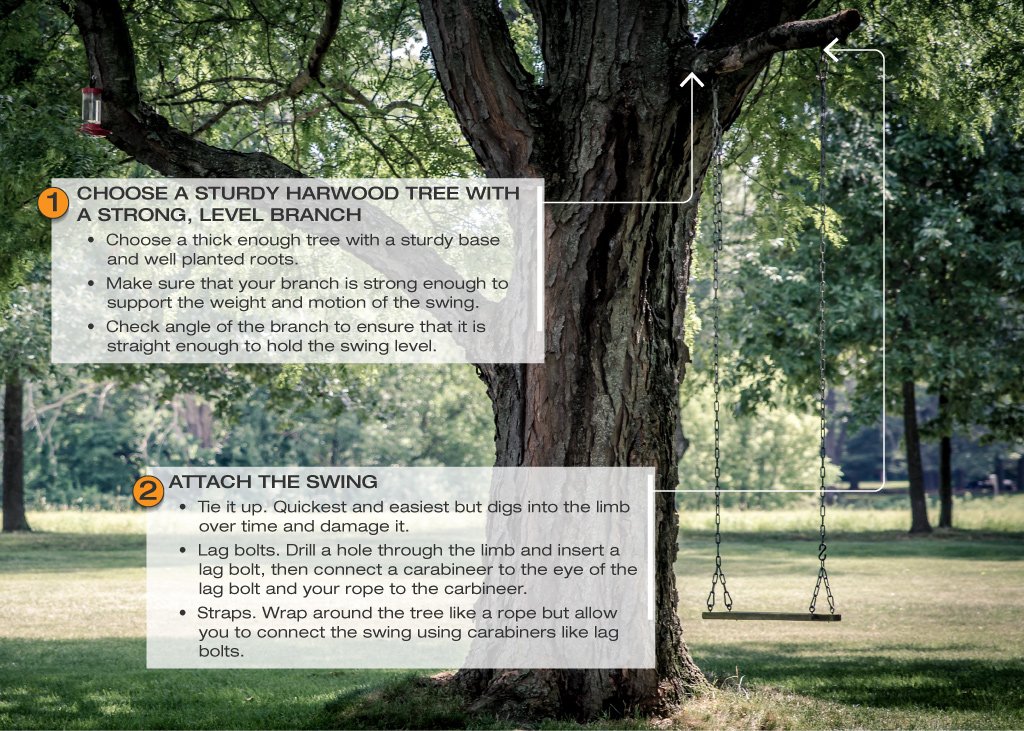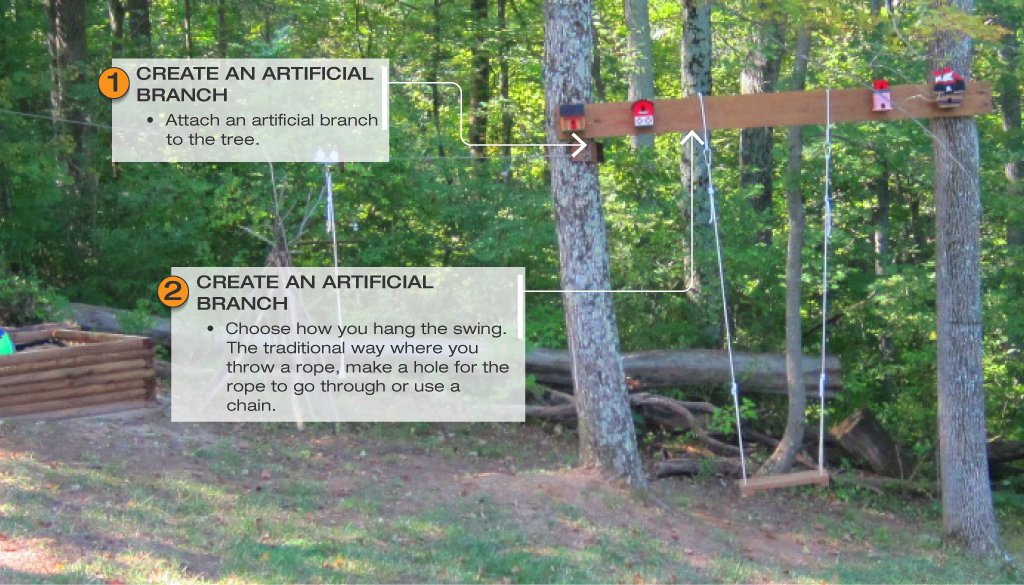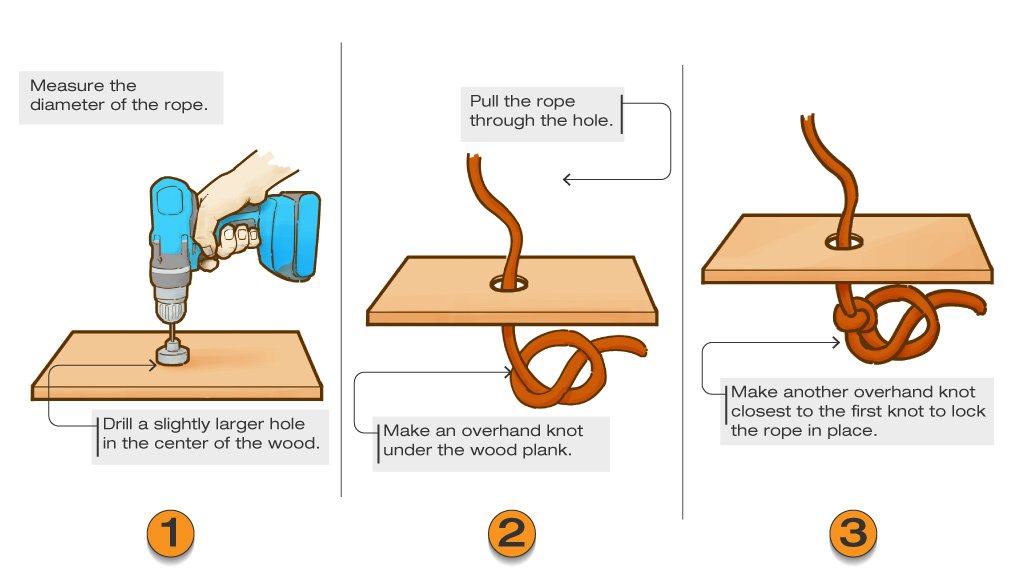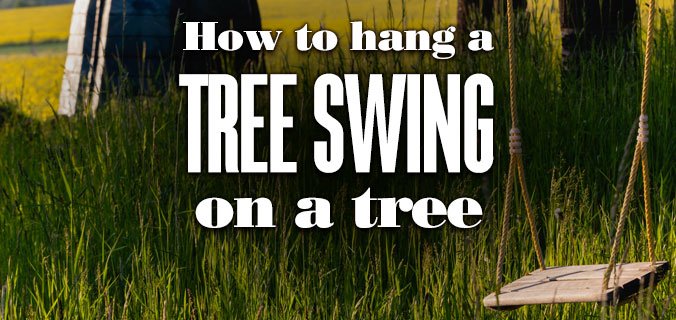A tree swing is a simple addition to any yard that will enhance any kid’s childhood, but not every house has the perfect tree swing tree. Even if you have the ideal tree, you will still want to think about several factors before starting, like what kind of swing you want, safety, and the height of the swing. This handy guide will cover everything you need to know about hanging a tree swing, whether you have the perfect tree or not.
How to Hang a Traditional Tree Swing
 Choose a Sturdy, Hardwood Tree
Choose a Sturdy, Hardwood Tree
The tree should be at least ten years old with a sturdy base and well-planted roots. Having that sturdy base and deep roots ensures that the tree will support the weight and motion. Maple and oak trees are both great options, but you’ll have to work with what you have.
Check the Integrity of the Branch
Just because the tree is sturdy doesn’t mean that the branch will be. This will also give you a chance to check your branch’s angle to ensure that it is straight enough to hold the swing level.
Attach the Swing
There are a few different ways to hang a tree, and it is all up to your preference on how you do it.
Tie it Up
This may be the most conventional way of doing it, and it is definitely the quickest and easiest, but it may not be the safest for the tree or the swinger. All you have to do is tie your swing ends around the branch, and you are good to go. This method’s problem is that if your knots aren’t tight enough, they can come undone and drop the swinger mid-swing. With this method, the rope will also move, which can cut into the limb over time and damage it – this can be prevented by putting a buffer between the rope and the tree like rubber tubing.
`Lag Bolts
A safer but controversial way to hang your tree swing is with lag bolts. You simply drill a hole in the limb and insert a lag bolt, then connect a carabineer to the eye of the lag bolt and your rope to the carbineer. This is a safer way to attach a swing, but it also causes momentary damage to the tree that can open it up to potential harm.
Straps
With time comes innovation and a newer invention is polyester straps that merge the best of both worlds. These straps wrap around the tree like a rope but allow you to connect the swing using carabiners like lag bolts. The straps are wide enough not to compromise the tree like rope, but they are strong enough to support people who are too heavy to be swinging.
How to Hang a Tree Swing from a Tree with No Branches
One frustrating situation that homeowners may run into is having the perfect older tree for a tree swing, except that it doesn’t have any suitable branches. A tree with no limbs is not ideal, but it is not a deal-breaker if you know how to do it.
 Create an Artificial Branch
Create an Artificial Branch
If there aren’t any suitable branches, you will have to create your own using building material. You will need to choose a material that is as equally sturdy as the tree, like a solid wood or metal beam. The beam should be able to stand up to the swing’s weight and motion, but it can’t be so strong that you aren’t able to drill holes in it. You don’t want your imitation branch to be too long either, as that will put unnecessary stress on the “branch” and the tree.
The next step is to attach the “branch” to the tree. There are several ways to accomplish this task with varying degrees of difficulty and damage to the tree. The most popular method is to attach the artificial limb using lag bolts in the same manner that you would attach a deck to a house. Most older trees will survive and even thrive after you attach the “branch,” but it is important to note that there is a possibility that connecting anything to a tree could damage it. Whichever route you choose, be confident that it will remain sturdy; the last thing you want is for a massive 2 x 6 to come crashing down on your child’s head.
Attach the Swing
Having an artificial branch is not the prettiest or best option, but it does hold some advantages. Since you installed the branch, you can choose how you hang the swing from it, whether in a traditional way where you throw a rope over it or create a hole for the rope to go through. Be sure to measure the length of the rope or chain you will use so that the swing is not too high or low.
How to Attach a Swing to a Tall Tree
Another issue that homeowners may run into is where they have the perfect tree, but the branches are too high. There is another option for homeowners who don’t want to install an artificial limb, but it may take some trial and error.

- Tie your tree swing rope around a rock or similar heavy object.
- Throw the rock over the tall branch you want to use for the swing; make sure to give yourself enough rope; otherwise, you may need to do this multiple times to make sure you have a long enough rope to make it over the limb and back to the ground — this is not your swing rope.
- Tie your swing rope, preferably with a buffer to protect the tree, to the throw line, and pull the throwline through to set up your actual swing rope.
- Tie a bowline knot to one end of the rope, then pull the other end through the knot until the rope is secure around the limb.
What is the Best Type of Rope for a Tree Swing?
Not just any rope will do, especially if you have an older child or plan on keeping the swing around for a while. There are plenty of options for ropes that work for tree swings and fit all needs.
- Chain
Chains are heavy duty and will support an adult’s weight, but it is also hard and could potentially lead to minor injury if the chain pinches or catches a kid wrong. Metal chains are also conductors, so your kids may not be comfortable holding a chain if it is too hot or cold out. Chains also need to be attached to lag bolts to work appropriately, which dictates how you will hang your swing.
- Paracord
This nylon rope is popular in many areas because of its function and durability. This rope is thinner, but it is incredibly strong and will support a large adult. Though it is one of the best options, it is not perfect; Nylon can be slippery, especially when wet, which makes it hard to grip, and it may stretch a bit over time, causing your swing to droop.
- Nylon Dock Line
This line has most of the benefits and disadvantages as paracord since it is made from the same material, but it is a little thicker. The weave of dock line is not as tight so that it may stretch a little more than paracord.
- Polyester Rope
Polyester is the best all-around rope thanks to its strength, durability, and ability to withstand the elements.
- What Not to Use
Polypropylene is a popular rope choice because it is thicker, but it is not as durable as Nylon or Polyester. The same goes for natural fibers like cotton, which are often chosen because they are soft to the touch, but they will rot quickly, creating a potentially dangerous situation.
How to Make a Tree Swing
Now that you know how to hang a tree swing, you won’t want to waste any time doing it. If you haven’t built a tree swing yet, consider these simple tree swing designs.
Single Rope Swing
 Supplies
Supplies
- 18 or 24 inches wooden round (found in most hardware stores)
- 1-inch rope
- Exterior Paint
- A drill with a 1-inch spade bit
Instructions
- Paint both sides of the wood round with exterior paint to protect it from the elements.
- Drill a hole in the center of the wood round.
- Thread the rope through the hole and tie a strong knot underneath the swing.
- Hang the swing.
Traditional Swing
Supplies
- Wood Plank
- Rope
- Saw
- Drill
- Router/Sand Paper
- Exterior Paint
Instructions
- Measure the plank’s length that you want to be the seat — 18 to 25 inches is the most common range.
- Cut the length of the board, then sand the edges of the seat.
- Paint both sides of the seat with exterior paint to protect them from the elements.
- Drill holes in all four corners of the seat.
- Cut your rope to the desired length leaving a little extra length for the knot.
- Slide one end of the rope through the top of one side of the seat.
- Pull a short length through the bottom of the hole on the same side of the seat.
- Tie a secure knot leaving a small loop between the two rope halves.
- Repeat steps 6 – 8 on the other side.
- Hang the swing.
Tire Swing
Supplies
- Tire
- Rope
Instructions
- Make sure to cut your rope with enough length to wrap around the inside of the tire multiple times.
- Loop the rope through the inside of the tire swing and over the top. Continue to repeat the loops until you have four or five circles around the top of the tire with enough rope left over to tie a knot.
- Tie a timber hitch or similar knot to the extended portion of the rope.
- Hang the swing.
Have Fun
Sometimes the classics are still the best, and tree swings are a true classic. They are relatively easy to set up, and your child will tell their grandkids about all the good times they had on their tree swing. Always remember to put safety first and measure twice, cut once.




Comments are closed.